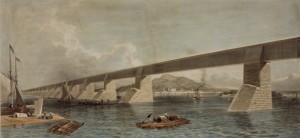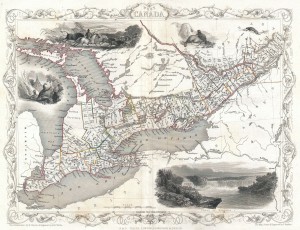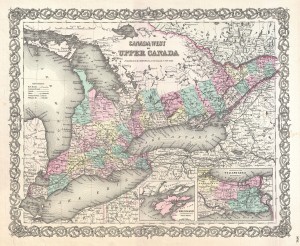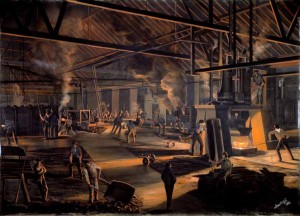9.9 Manufacturing, Railways, and Industry: Early Days
Manufacturing — the process of adding value to raw materials by turning them into something else — was limited in British North America by continued mercantilist attitudes in Britain and by American restrictions. Nonetheless, there were examples of manufacturing to be found, such as rope making in Halifax, hat making in Quebec City, and shipbuilding in almost every port town. The canal excitement of the 1830s fed demand for locally produced tools like shovels and wheelbarrows, some of them made in workshops that would become agricultural implement factories.[1]
But the markets were small in British North America so the growth of local manufacturing depended on access to external markets. Britain didn’t need much of what British North America had to offer apart from raw materials. And in 1828 the United States introduced a system of tariffs that was meant to protect embryonic industries in the northern states (New England was a particular beneficiary). Most of the industrial manufacturers that were targeted came from Britain; British North American exports suffered as well.
For the first 50 years or so of the 19th century, therefore, manufacturing growth took place principally in areas of production that served the British North American market itself. One example was the cotton mill established in Sherbrooke (the first joint-stock company to be incorporated in Canada) in 1845, but the biggest driver of economic change was railway development.[2]
Railways were to the mid-19th century what freeways and airports were to the 20th. That is, they were potentially very efficient means of moving goods and people, they were enormously expensive to construct and typically required government involvement (whether directly or indirectly through loans), and they were the mark of an up-to-date economy and country (or colony). As well, railways didn’t suffer from cold weather as waterways did — they offered the potential of year-round service and they could, theoretically, go wherever they were needed, unlike canal systems which depended on water routes.
The first railways in Canada were temporary structures, usually made of wooden rails and used to move quarried rock. One such railway was built at Louisbourg in the early 18th century and another — more like a steam-winch-powered cable car — was used to build the new Quebec Citadel in 1820. The first true railway, however, appeared in the 1830s, running about 36 kilometres from La Prairie (across the St. Lawrence from Montreal) to the head of Lake Champlain. From there water transportation took over as goods were transferred to boats and sailed downriver to New York. The second railway built in British North America was shorter still: a 9.5 kilometre line from Albion Mines to Pictou, Nova Scotia.
Much more significant was the St. Lawrence and Atlantic Railroad, which opened in 1853. It was important for three reasons: first, it was broad gauge (rather than standard) and thus set the standard for future railroads in Canada until the 1870s; second, it addressed the centuries-old irritant of Montreal merchants who longed for an ice-free port by joining the largest Canadian city with Portland, Maine; third, it was an international railroad, the first in the world.
The Great Western Railway (1855) subsequently linked Windsor and Detroit to Toronto, Hamilton, and the Niagara district, while the Toronto, Simcoe, and Lake Huron Railway (also 1855) further locked in Toronto as Canada West’s hub city. The largest and most ambitious of the pre-Confederation railroad projects, however, was the Grand Trunk Railway, which eventually connected Montreal and Toronto, in part by leasing or otherwise absorbing these smaller independent railways. Fortunes were invested in these projects and a whole generation of British North American capitalists and banks made even larger fortunes back. Land and material sales were key to profits, most of which appear to have been made before the first train chugged down the line.

The value of railways in Canadian economic history is often misunderstood. Railways in many respects duplicated what had already been accomplished by canals and added little to the economy that was truly new. Some of the earliest experiments were, in fact, referred to as “canal railways” because they paralleled existing water routes. This was certainly the case with the 12-kilometre Montreal and Lachine Railroad, built in 1847. In British North America, the first railways have been described as a duplication and extension of the Empire of the St. Lawrence, corridors of trade that echoed, rather unimaginatively, the trade routes first developed under New France (if not under the Wendat and Haudenosaunee). It was for this reason that railways were perilous investments: in British North America they were necessarily very long, they competed with existing water transportation routes, and they offered little to emerging manufacturers.
Exercise: Documents
Canada South
It may be west of Montreal and Old Canada, but Canada West is very definitely farther south than much of the rest of the country, including all of what is now Western Canada. These two maps (Figures 9.E2 and 9.E3) show the same region in the 1850s.


They are, however, profoundly different representations of southern Ontario.
What changes can you see? What is being emphasized in the first that was not so important or interesting to the cartographer and artist who produced the second?
Beginning an Industrial Revolution
What railways did offer (and what is easy to overlook) is a stimulus to heavy industry, to say nothing of demand for squared timber for ties and trestles. Steel for rails, rolling stock, and engines represented a major new demand factor in the economy. Iron and steel foundries appeared and gradually diversified. The availability of surplus iron and steel stimulated growth in other kinds of manufacturing, principally associated with working implements. Shovels, axes, and pickaxes — the trademark tools of the farmer, the logger, and the miner — were beneficiaries of the railway industry. They were needed in such enormous quantities that investment in metal-bashing shops became very attractive and tools became more generally available.

The Newcastle Foundry and Machine Manufactory provides a useful example of how industries complemented each other. Established in 1847 in Newcastle, Canada West, by Daniel Massey, this was the chrysalis from which Massey Manufacturing and then Massey-Harris and, in the 20th century, Massey-Ferguson would emerge. Massey began by pioneering the production of mechanical threshing machines, which was possible only because of the availability of all kinds of metal products, everything from iron ingots to nails. From Newcastle, Massey could ship up and down Lake Ontario, but there was limited roadway access to the interior of the colony. By the mid-1850s the company relocated to Toronto where it had improved access to raw materials, nearby foundries, and farmers to whom it could sell its products. This small industrial revolution, so intimately related to the agricultural well-being of the colony, had an almost immediately perceptible effect. One observer in 1860 commented that “an American machine is now as great a rarity as a Canadian one was a few years ago.”[3]
This focus on, and success in, the manufacturing of agricultural implements followed on the continued Upper Canadian belief in an expanding farm frontier as an engine of growth and the wheat economy. Implement manufacturing, then, was something of an advance in terms of industrialization, but it ultimately preserved the staples orientation of the wheat economy and did not lead to agricultural diversification. That is to say, a threshing machine does nothing to push a farm economy from monoculture to robust self-sufficiency and, say, wool production.
Creating a Working Class
The rise of farm implement production had an unintended impact on the Canadian economy: it reduced the need for farm labour. In doing so it freed up younger members of farm families, specifically those who were not in line to inherit the farm. Some of these men and women looked west to new farming opportunities in Upper Canada while others moved to the towns and cities to pursue wage labour. Put less charitably, perhaps, farm machinery created circumstances in which the big farm family was not needed; some families had to shed a few members, sending them off to take their chances, perhaps working for Massey in Toronto. This change marked the emergence of a locally produced market of free labour: “free” in the sense of being removed from other obligations and free to move to wherever the jobs and opportunities arise.
Whatever factories came into existence in British North America before Confederation were not, to be sure, very large. One study claims that “the average Upper Canadian manufactory employed less than five workers.”[4] The railway companies were the largest employers — some of them marked by the vertical integration of foundries, equipment manufacturing, line construction and maintenance, connections with ports and shippers, and even the housing of their workers. By 1871, nearly 3,000 British North Americans worked for the principal railway firms.[5]
Environmental Costs
These numbers hint at the scale and breadth of production necessary to keep these industries moving. As railways extended the reach of industry deeper into rural areas, new resources could be tapped. Logging for the manufacture of railway ties accelerated, and with it came soil erosion and stream damage. Fish spawning grounds were impacted as rivers silted up. Even the production of sawdust in industrial quantities affected water quality. As well, iron and steel production required a mining industry to supply the key ingredients: iron ore and coking coal. Iron mines opened around Lower Canada and coal mines in Cape Breton. By mid-century hundreds were employed as wage labourers underground and in iron forges.
The production of coke — coal from which impurities have been removed — began in earnest in Canada in these years and augmented the production of charcoal (coke is much better in the smelting process but the tar residue is much greater and much more toxic, as 20th century Nova Scotians would discover to their sorrow). Steam engines, whether on rails or on the water or in mills, increasingly required coal as well. The needs of the Royal Navy often determined the location and success (or failure) of coal mines, as was the case in Cape Breton and on Vancouver Island. Coal tips (piles of waste earth, stone, and unmarketable small pieces of coal), began to grow on the landscapes abutting Sydney, Nova Scotia, and Nanaimo, on Vancouver Island. Dust from the tips and from the coal heaped on the docks was in the air where everyone — even those who never ventured underground — would breathe it in. Many from those communities were exposed to the toxins, and at risk for developing — and dying from — silicosis.
No one at the start of British North America’s industrial revolution could have imagined the millions of tons of material that would be won from under Earth’s surface in the decades ahead, nor could they know the full environmental consequences of their actions. By 1860, however, the purity of water and soil and cellular matter was already being severely compromised in areas of early industrialization.
Key Points
- Lack of access to larger markets limited the scale of manufacturing experiments in British North America before the mid-19th century.
- Railways became the key to unlocking industrial potential, linking producers to markets, and creating demand for heavy industrial output.
- Agricultural implement production otherwise dominated industrial output and helped advance the farming sector.
- Industrialization and the improvement of farming technology led to a migration from farms to cities in search of seasonal and then full-time employment in wage labour.
Attributions
Figure 9.12
Grand Trunk Railway of Canada, Victoria Bridge, now constructing across the St. Lawrence River at Montreal by Skeezix1000 is in the public domain.
Figure 9.E2
West Canada by BotMultichill is in the public domain.
Figure 9.E3
Canada West or Upper Canada by BotMultichill is in the public domain.
Figure 9.13
Toronto Rolling Mills by Skeezix1000 is in the public domain.
- Bryan D. Palmer, Working-Class Experience: Rethinking the History of Canadian Labour, 1800-1991, 2nd edition (Toronto: McClelland & Stewart, 1992), 38-9. ↵
- Jean-Pierre Kesteman, “GALT, Sir ALEXANDER TILLOCH,” in Dictionary of Canadian Biography, vol. 12 (University of Toronto/Université Laval, 2003). Accessed December 2, 2014, http://www.biographi.ca/en/bio/galt_alexander_tilloch_12E.html . ↵
- Quoted in Richard Pomfret, "The Mechanization of Reaping in Nineteenth-Century Ontario: A Case Study of the Pace and Causes of the Diffusion of Embodied Technical Change," in Perspectives on Canadian Economic History, ed. Douglas McCalla (Toronto: Copp Clark Pitman, 1987), 81. ↵
- Palmer, Working-Class Experience, 38. ↵
- Paul Craven and Tom Traves, "Canadian Railways as Manufacturers, 1850-1880," in Perspectives on Canadian Economic History, ed. Douglas McCalla (Toronto: Copp Clark Pitman, 1987), 127-8. ↵

